News
MRI hits a high of 20,000 RT-PCR tests
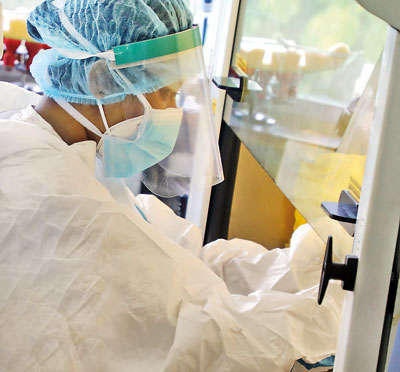
A Medical Laboratory Technician engaging in the bio-safety cabinet extraction step. Pix by M.A. Pushpa Kumara
Twenty thousand ‘gold standard’ RT-PCR tests and continuing!
This is the “significant” achievement of the Department of Virology, Medical Research Institute (MRI) and is due to major teamwork, all categories including Consultants, Medical Laboratory Technologists (MLTs) and orderlies working night and day, says Consultant Medical Virologist, Dr. Jude Jayamaha.
So far Sri Lanka has performed around 60,000 RT-PCR (Reverse Transcription-Polymerase Chain Reaction) tests at several hospitals and university laboratories spread across the country, with the MRI having to its credit 1/3rd of the total.
Now the Department of Virology is also looking into the possibility of establishing ELISA (enzyme-linked immunosorbent assay), a serology assay to check people for antibodies which would indicate whether they have already been exposed to the virus.
With much discussion recently about ‘false positives’ and ‘false negatives’ in RT-PCR testing, Dr. Jayamaha takes the Sunday Times through the strict World Health Organization (WHO)-approved protocols of this complex procedure at his department to ensure accuracy.
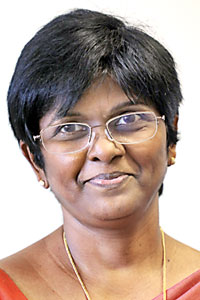
Consultant Virologist Dr. Janaki Abeynayake
The department established the test for SARS-CoV-2 (the new coronavirus which causes COVID-19) on January 26. The very next day came the samples from the Chinese woman tourist who was the first case reported in Sri Lanka.
The MRI which is the national referral centre receives 400-500 samples from all over the country each day and does seven runs daily till midnight. These samples include those from hospital patients (both new and follow-up samples), quarantine centres, random sampling from the community, those who are returning from abroad, suspected deaths and those taken as part of the SARI (Severe Acute Respiratory Illness) surveillance.
Referring to how they ensure quality, Dr. Jayamaha says that early in the pandemic, 32 samples from the MRI were sent to two independent laboratories for conformation as a quality test and got 100% conformity. As another quality control measure, each test is validated against the machine as well as the RNA (ribonucleic acid) extraction method.
“All this is done for quality assurance and to avoid false positives and false negatives. We also take swabs from the environment within the testing rooms, the machines and benches to make sure that there is no contamination,” he said.
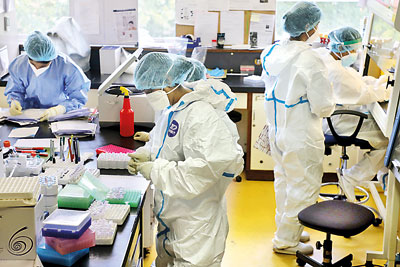
The laboratory staff processing the samples, a high-risk task
Certain factors could affect the end result and also the quality of the test. These factors include sample-taking, transport and processing which is the laboratory component, it is understood, with the three stages being ‘pre-analytical’, ‘analytical’ and ‘post-analytical’.
With vital aspects being how a sample should be taken, from where in the respiratory tract it should be taken, whether the person taking it is trained and how the sample is packed in the viral transport media before being sent for testing, the Sunday Times learns that the Health Ministry has issued guidelines, while quality checks are carried out by the Epidemiology Unit on sample collection and tallying of samples with the right labelling, while the MRI checks for leakages of samples and also the quality of samples.
Two counters have been set up at the MRI, explains Dr. Jayamaha, with the first accepting the sample-batches, tallying them against the request form and assigning a five-digit number to each sample. It is at the second counter that the staff in Personal Protective Equipment (PPE) opens the triple-packing of the potentially highly-infectious sample and checks for leakage as well as for identification and labelling once again.
There are four physically separated rooms:
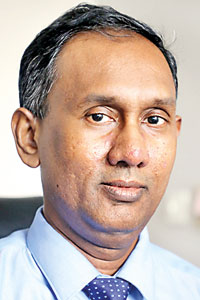
Dr. Jude Jayamaha
1st room – is the extraction room, where the sample is treated with several chemical solutions to remove substances such as proteins and fats and in the case of the new coronavirus, the RNA is extracted. This RNA is a mix of a person’s own genetic material and, if present, those of the virus.
2nd room – is the master-mix room where the main PCR ingredients are added in small amounts to test tubes.
3rd room – is the sample adding room where into the small test tubes are added the extracted RNA.
4th room – is where the RT-PCR machine is and the samples are sent through it and millions of copies made of a positive sample
Going into detail as to what happens in the 4th room, Dr. Jayamaha says that it is here that the RNA is reverse transcribed using a specific enzyme and placed in the RT-PCR machine, with a mixture of viral-specific primers. The machine cycles through temperatures that heat and cool the mixture, to trigger specific chemical reactions that create new, identical copies of the target sequences of the virus.
Marker labels get attached to the newly-synthesized viral nucleic acid and release a fluorescent dye, which is measured by the machine’s computer and presented in real-time on the screen. It is when the measurement goes over a certain level of fluorescence through the cycle-process that there is confirmation of the presence of the virus. How many cycles it takes to reach this level is also an indicator of the degree of the viral copy numbers present.
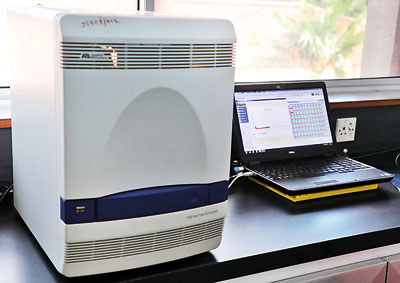
The real-time RT-PCR machine at work
“All the four rooms have dedicated equipment and nothing is moved from one room to another to make sure that there is no contamination. The staff within those rooms even has dedicated coats, etc.,” says Dr. Jayamaha, reiterating that the interpretation of the amplification curve is done by people with vast experience at the Department of Virology.
The Virologists collate the findings with the other data, both epidemiological and clinical and give results as a holistic picture. This is not a push-button process. We get the raw data which is analyzed with clinical and epidemiological data and come up with the result whether positive or negative, he adds.
The real-time RT-PCR is a powerful tool when considering that analytical sensitivity is 100%. However, the clinical sensitivity would vary depending on a few factors such as the sample taken, tools used and the day of illness. The false positives and negatives can rarely come about due to this, he adds.
False positives & negatives
How do ‘false positives’ or ‘false negatives’, the subject of much discussion, come about from real-time RT-PCR testing?
This is a biological factor, explains Dr. Jude Jayamaha and depends on the shedding of the virus. It could also vary depending on which section the sample has been taken from – whether lower or upper respiratory tract and the quality of the sample.
Explaining that false reports are generally a rarity, he said that a cardinal feature is to co-relate the test findings with other factors such as epidemiological and clinical features.
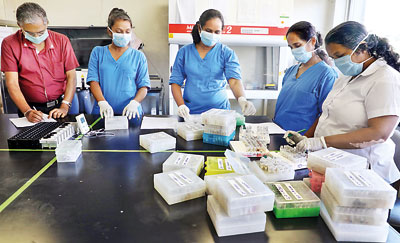
Orderlies sorting out the serum samples


